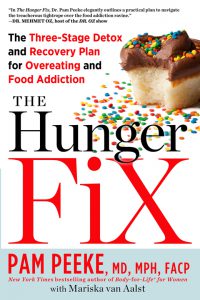Food Addiction, Dr. Peeke & The Hunger Fix
Food addiction is real. We find ourselves putting on weight when we are trying our hardest not to. We are hard-wired to crave certain foods, but that is only part of the problem with this rising epidemic.

by guest blogger Pam Peeke, MD, MPH, FACP, best-selling author and expert on health, fitness, and nutrition
One year ago I launched my book, The Hunger Fix: The Three-Stage Detox and Recovery Plan for Overeating and Food Addiction (Rodale 2012), on Katie Couric’s show. Within five days it became a New York Times best seller. The overwhelming feedback makes it clear that I touched a collective nerve. Men and women are relieved to read the new groundbreaking science that explains the distressing mystery as to why one, two, or even six cupcakes can never satisfy: Your brain had been hacked and hijacked.

Happily, The Hunger Fix is now relaunching in paperback and therefore, it’s a great time for an update with some of the emerging science that further strengthens what I’ve summarized in the book. Here are highlights (in the form of frequently asked questions) to enlighten you:
• What have scientists discovered about food addiction? Dr. Nora Volkow, director of the National Institute of Drug Abuse at the National Institutes of Health has been a leading scientist exploring the relationship between food and addiction, along with her colleague Dr. Gene Jack-Wang, of the Brookhaven Labs. Their teams found that it was primarily the continuous exposure to the “hyperpalatables”–sugary/fatty/salty foods, often refined and processed–that caused profound changes in the brain’s reward center, resulting in a decreased number of receptors for the reward/pleasure neurotransmitter dopamine. This then leads to a vicious cycle of overeating and bingeing.
Dr. Volkow used tools such as PET scans and functional MRIs of the brain to determine that cues in the environment (such as ads on TV and radio, as well as smells and visuals) trigger an unstoppable yearning for a food. Scientists have added to these findings by showing that the prefrontal cortex, the center for executive function, was impaired during active addiction. As a consequence, the ability to use willpower and make the right decision was grossly hampered. Thus, two essential parts of the brain undergo significant organic changes leading to the perpetuation of food addiction. Food addiction, then, involves a serious psychobiological challenge.
• How many people have food addiction? A recent study of 652 men and women in which researchers used the Yale Food Addiction Scale to assess the prevalence of the addiction, found that:
- Around 1 in 20 people (5 percent of the general population) met the criteria for food addiction
- There are a large number of people who don’t meet all of the criteria but who demonstrate a strong association between food and addictive behavior–the “almost addicted”
- Those with food addiction were heavier and had higher body fat percentages
- Women were more affected than men.
This is one of the first studies to provide a glimpse into the magnitude of this problem in the general population. It’s important to note that people who struggle with food addiction span the range of body sizes, from skinny to obese. The difference is in controlling the total daily number of calories ingested and expended.
• Am I a food addict? There’s a validated and peer-reviewed assessment you can take to find out if you have or are on the verge of food addiction. Known as the Yale Food Addiction Scale, this quiz is used by scientists for clinical and research work. You can take the full 27-item assessment, which is provided in The Hunger Fix, or complete the shorter version. Food addiction is indicated when there are three or more symptoms present within the past 12 months and the individual experiences serious functional impairment or distress in his or her daily life.
• What’s the relationship between food addiction and binge eating?Researchers have found a significant crossover between these two conditions. Yale researcher Ashley Gearhardt published data noting that those who experience binge eating and meet the criteria for food addiction are more likely to experience a higher level of mental and physical distress than binge eaters who do not meet the criteria. What exactly is binge eating? It’s the most common form of disordered eating and involves at least 30 percent of the population. Standard criteria for the diagnosis of binge eating include the presence of recurring episodes (at least once per week) of eating much more food than normal in a short period of time, often when not hungry, followed by feelings of being out of control, as well as shame, blame, and guilt. You can clearly see the overlap with food and addiction.
An exciting recent development is the inclusion of binge eating disorder in the fifth edition of Diagnostic and Statistical Manual of Mental Disorders (the DSM-V). This means that those seeking help for weight management who have issues with binge eating and its often-associated food addiction will soon have insurance coverage for inpatient and outpatient treatment programs.
• How do you treat food addiction? The Hunger Fix is the first consumer book to provide readers with both the science and the solution for overeating and food addiction. There is a range of options–from 12-step to cognitive behavioral therapy–to tackle the problem of food addiction. I have found that most people cherry-pick from many of these resources to customize a plan that works best for them. The book will help guide you through this process.
The over-arching goal is to create a new strategy for lifelong recovery. Food addiction presents a unique challenge. It’s unlike an addiction to drugs or alcohol in that you need food to live. You’re surrounded by cues to eat 24/7, as well as the daily stresses that drive overeating. The recovery strategy has to include a healthy lifestyle to provide the mental, nutritional, and physical activity elements that will support lifelong recovery. The Hunger Fix lays down a framework for healing and strengthening the brain’s reward and executive function centers. In three stages–Detox and then Beginner and Master Recovery–you’ll learn how to substitute False Fixes (the hyperpalatables, people, places, and things that enable your overeating) with Healthy Fixes (whole foods, stress resilience, and mental and physical fitness).
The ultimate reward, once you reclaim your brain as well as your life, is the joy and happiness you’ll feel pursuing cherished dreams. That’s a hunger you can spend a lifetime satisfying.
 Pamela Peeke, MD, MPH, FACP, is a Pew Scholar in nutrition and metabolism, assistant professor of medicine at the University of Maryland, and a fellow of the American College of Physicians. A triathlete and mountaineer, she is known as “the doc who walks the talk,” living what she’s learned as an expert in health, fitness, and nutrition. Dr. Peeke is featured as one of America’s leading women physicians in the National Institutes of Health Changing Face of Medicine exhibit at the National Library of Medicine. Her current research at the University of Maryland centers on the connection between meditation and overeating. She is the author of many best-selling books, including Fight Fat after Forty. Her new book is the New York Times best-seller The Hunger Fix.
Pamela Peeke, MD, MPH, FACP, is a Pew Scholar in nutrition and metabolism, assistant professor of medicine at the University of Maryland, and a fellow of the American College of Physicians. A triathlete and mountaineer, she is known as “the doc who walks the talk,” living what she’s learned as an expert in health, fitness, and nutrition. Dr. Peeke is featured as one of America’s leading women physicians in the National Institutes of Health Changing Face of Medicine exhibit at the National Library of Medicine. Her current research at the University of Maryland centers on the connection between meditation and overeating. She is the author of many best-selling books, including Fight Fat after Forty. Her new book is the New York Times best-seller The Hunger Fix.
Original Article by: Maria Rodale at HuffingtonPost





